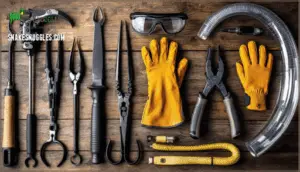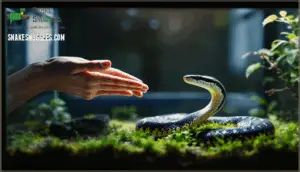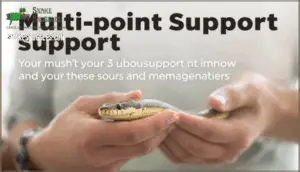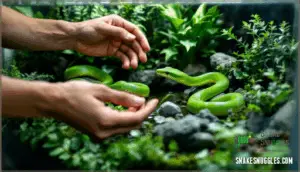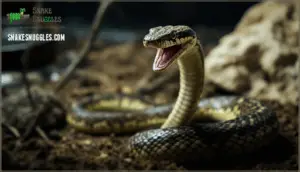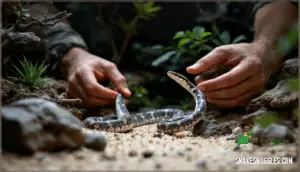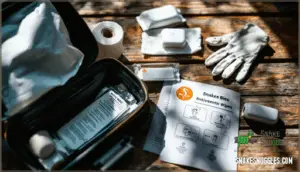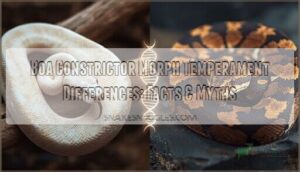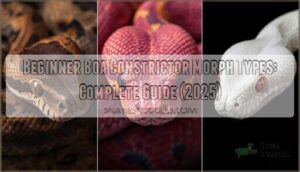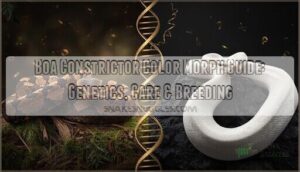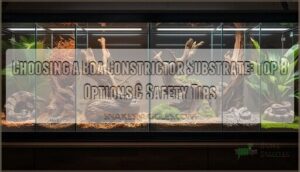This site is supported by our readers. We may earn a commission, at no cost to you, if you purchase through links.
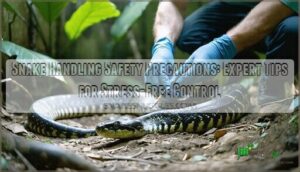 A ten-foot python can slip through a half-inch gap faster than you can say “Where’d it go?” That’s the sort of reality snake wrangling experts live with—one misstep, one missed latch, and suddenly you’re looking for a scaly Houdini behind your washing machine.
A ten-foot python can slip through a half-inch gap faster than you can say “Where’d it go?” That’s the sort of reality snake wrangling experts live with—one misstep, one missed latch, and suddenly you’re looking for a scaly Houdini behind your washing machine.
Snake wrangling isn’t about bravado or reckless grabs; it’s methodical, clear-eyed caution, built on routines and instincts honed by plenty of close calls.
When you treat snake wrangling safety precautions as second nature, you don’t just protect yourself—you keep the reptiles calm and your surroundings secure, setting the stage for confident, stress-free control every time you open that enclosure.
Table Of Contents
Key Takeaways
- Snake wrangling safety depends on methodical preparation—securing your space with escape-proof enclosures, removing hazards, and having emergency contacts ready before you ever handle a reptile.
- Proper handling technique requires supporting the snake’s body at multiple points (one hand a third behind the head, another at mid-body), moving slowly, and recognizing when not to handle during shedding, feeding, or signs of stress.
- Reading species-specific warning signals like coiling, hissing, raised head position, and defensive postures helps you avoid bites by respecting the snake’s boundaries and adjusting your approach before aggression escalates.
- Emergency response requires immediate action—photograph the snake for identification, skip tourniquets, clean and immobilize the wound, and seek medical attention within six hours for venomous bites while watching for symptoms like paralysis or severe swelling.
Preparing Your Space for Safe Snake Handling
Before you get hands-on with any snake, your space needs to be set up for safety. The right environment makes all the difference in keeping you and your reptile calm and secure.
Let’s look at what you’ll need to get started.
Securing The Handling Area
Before you even think about picking up a snake, making sure your interaction area is secure is like locking the front door before you go to bed—absolutely essential for everyone’s safety. Environmental Controls matter, too—think of these as your first line of defense.
- Check all enclosure latches and seals for Escape-Proofing Methods.
- Implement Containment Protocols to keep snakes in designated zones.
- Use child and pet barriers for added Snake Safety Precautions.
Don’t forget Childproofing Snakes and Pet Safety as part of your overall strategy.
Removing Hazards and Escape Risks
Scan the room for breakable objects and secure cables—snakes love a tangle almost as much as Houdini loved an escape act.
Door security is key; close every exit, and double-check for gaps.
These escape prevention steps cut down entanglement risks and keep your session focused on safe snake care techniques, not a frantic chase for your slippery friend.
Choosing The Right Enclosure Design
Once your space is escape-proof, it’s time to size up your snake enclosure. A well-designed habitat balances:
- Size Requirements—at least equal to your snake’s full length.
- Escape Prevention—secure locks, no gaps.
- Ventilation Control—6–12 square inches, never sacrificing humidity.
To guarantee proper thermoregulation, a temperature gradient is essential. Species adjustments and monitoring practices keep your reptile care sharp and your snake stress-free.
Setting Up Emergency Plans and Contacts
Once your enclosure is locked down and escape-proof, it’s smart to have your emergency plan and contacts lined up before you ever open the lid. Map hospital routes, check antivenom availability, and keep a contact list handy. Review insurance details and establish evacuation protocols.
Emergency preparedness and response isn’t just a checklist—it’s your safety net when quick thinking matters most.
Selecting Proper Equipment and Protective Gear
Choosing the right gear is the backbone of safe snake management. You want tools and protection that work as hard as you do.
Here’s what you should look for when setting up your enclosure.
Using Snake Hooks, Tongs, and Tools
Ever tried picking up a spaghetti noodle with your bare hands and found it slippery? Managing a snake isn’t much different—unless you’ve got the right hook or tongs in your grip. With the right Snake Management Equipment, you get:
- A safe grip for control and confidence
- Proper Hook Material for the job
- Species Specificity—different tools for different snakes
- Tool Maintenance for lasting reliability
Choosing and Maintaining Protective Gloves and Boots
Before you reach for that snake, let’s talk about the boots and gloves that deserve a spot in your safety kit. Choose puncture-resistant gloves and boots built for bite resistance—don’t just wing it with garden gear. Maintenance matters! Regularly inspect your protective clothing.
Here’s a handy table for quick reference:
| Glove Material | Boot Construction | Maintenance Schedule |
|---|---|---|
| Heavy-duty Kevlar | Tall, reinforced leather | Inspect after each use |
| Synthetic blends | Composite toe | Monthly cleaning |
| Leather | Thick tread sole | Replace if punctured |
| Chainmail woven | Double stitching | Check seams regularly |
| Bite-resistant | Waterproof lining | Dry thoroughly to store |
Selecting Secure Terrariums (e.g., REPTI ZOO Front Opening Terrarium)
If you want your snake to stay safe and sound, the terrarium you choose will make all the difference. Go with tempered glass for strength, and don’t cut corners on lock mechanisms—they’re your last line of defense for escape prevention.
The REPTI ZOO front-opening model shines for reptilekeeping: it balances ventilation needs, promotes easy maintenance, and guarantees reptile health and safety.
Handling Techniques to Prevent Stress and Injury
Safe snake care starts with small, thoughtful moves and a steady hand. If you’re wondering exactly how to keep both you and your snake out of trouble, you’re in the right place.
Here’s what to keep in mind before you reach for that enclosure.
Approaching Snakes Calmly and Safely
Staying calm around a snake is a bit like defusing a tense situation—your steady nerves set the tone for everything that follows. Use a calm approach, moving slowly and watching for visual cues in the snake’s body language. Avoid startling your snake; respect its space.
These care techniques are the foundation of safe snake care practices and build trust on both sides.
Supporting The Snake’s Body Correctly
Think of lifting a rope bridge—would you grab one end and hope for balance? Proper Grip means supporting your snake with both hands: one a third behind the head, the other beneath the mid- or rear body.
It’s important to understand how to safely catch the snake before interacting with it. That’s Multi-Point Support in action—essential for Injury Prevention, Equipment Safety, and mastering Snake Handling Techniques while closely reading snake body language cues.
Avoiding Sudden Movements and Aggressive Gestures
Nothing sends a snake’s nerves jangling faster than a jerky hand or twitchy move—think of how you’d feel if someone waved a broom at your feet. Calm Approach is everything.
Use Slow Movements and a Gentle Touch to Respect Space and avoid startling your snake. These care techniques keep stress at bay and help you read subtle body language or defensive signals in real time.
Knowing When Not to Handle Snakes
Just as moving slowly puts your snake at ease, knowing when to keep your hands off is an art every caretaker soon masters. Skip interacting if your snake’s in a shedding cycle, recently fed, brumating, or showing obvious stress.
Respect defensive signals and snake behavior, maintaining a safe distance—after all, Snake Interaction Safety also protects your snake’s health and prevents bites.
Recognizing Snake Behavior and Warning Signs
Before you ever reach in to touch a snake, it pays to understand what it’s telling you. Reading the warning signs—like shifts in posture and behavior—can mean the difference between a calm session and a risky one.
Let’s look at the telltale signals every caretaker should watch for.
Identifying Stress and Defensive Postures
Even the calmest snake will tell you when it’s feeling on edge—you just have to know how to read the signs. Watch for classic defensive signals: Coiling behavior means it’s ready to defend, while hissing sounds increase the warning.
If you spot a raised head or a tightly coiled body, you’ve got classic strike posture. Tail signals? That’s your cue to keep a safe distance.
Understanding Species-Specific Signals
Signal variations from snake to snake are real—contextual interpretation is your best tool. Ball pythons may freeze, while rat snakes thrash. Venomous species often have their own signature defensive signals.
Habitat influence shapes body language, too. Learning signals unique to each species is foundational for Snake Safety, and understanding these behavioral differences sharpens your instinct for reading snake behavior.
Responding to Signs of Agitation or Aggression
When a snake’s body language shifts from calm to coiled, it’s your cue to pay close attention and adjust your approach before a small warning turns into a big problem.
Defensive postures—like hissing, rearing, or a fixed stare—signal brewing stress or aggressive behavior. Respect those stress signals.
Practice safe retreat, remembering that species differences demand flexible strategies for snake care safety.
Emergency Response and Bite Prevention Tips
In emergencies, having a plan can make all the difference. Quick thinking and the right safety measures keep both you and your snake protected.
Here’s what you’ll want to have ready just in case.
First Aid Procedures for Snakebites
Ever hear the phrase, “Time is tissue”? With venomous snake bites, every minute counts. Start Emergency Response and First Aid by skipping the tourniquet—those do more harm than good.
With venomous snake bites, every minute counts—skip the tourniquet and focus on wound cleaning and immobilization instead
Focus instead on Wound Cleaning with soap and water, then use Immobilization Methods for the bitten limb.
Stay calm, call Medical Transport, and seek antivenom timing within six hours for best results.
Photographing and Identifying Snakes After Bites
If you’ve ever wondered why herpetologists urge you to snap a quick photo after a snake bite, it’s because the right picture could be your ticket to faster, more effective treatment.
For safe, accurate Bite Identification, always focus on:
- Photo Clarity from a Safe Distance
- Species Verification for Venomous Snake Identification
- Clear Documentation Importance for emergency response and first aid
When to Seek Medical Attention
Out on a snake job and feeling uneasy? Swift action is key. Seek immediate medical care for Envenomation Symptoms—think trouble breathing, severe pain, or sudden weakness. Don’t delay Antivenom Timing; every hour matters for Hospital Recovery. Below, spot-check the most urgent Clinical Indicators and Emergency Protocols.
| Emergency Sign | What It Means | Action |
|---|---|---|
| Sudden Paralysis | Neurotoxic Envenomation | Hospital Now |
| Profuse Swelling | Venom Spread | Emergency Room |
| Fainting/Shock | Circulation Failure | Call Emergency |
Preventing Bites With Safe Handling Practices
You’d be surprised how many bites can be dodged with a little patience, the right gear, and knowing when to keep your hands to yourself. Embrace a calm approach and respect your snake’s space—think of it as negotiating for peace, not starting a standoff.
- Always use snake hooks and proper tool usage for distance.
- Never skip protective gear.
- Support the snake’s midsection, never grab the head.
Frequently Asked Questions (FAQs)
How often should snake handling equipment be inspected?
Inspect your snake hooks, tongs, and protective gloves before every session to catch cracks, wear, or damage. Replace gear showing significant deterioration—professional-grade equipment maintains effectiveness only with regular evaluation and timely replacement.
Can children safely handle certain snake species?
Roughly 9% of adult snakebites happen at work.
Kids can safely interact with docile species like corn snakes or ball pythons with proper supervision, protective gear, and hands-on interaction education that emphasizes parental responsibility and snake behavior recognition.
What temperature affects snake handling behavior most?
Temperature influence is key—snakes become sluggish below 70°F and defensive above 85°F. Ideal ranges between 75–80°F minimize stress from being picked up and promote predictable snake behavior, though species variation means you’ll need to adjust environmental control based on your specific species.
Should you handle snakes during shedding periods?
It’s best to give your snake a pass during the “blue phase” when their eyes cloud over—Shedding Stress peaks then, causing Skin Sensitivity and Temperament Changes that increase Interaction Risks.
Post-Shed Interaction is safer once vision clears.
How long after feeding should handling wait?
Wait at least 48 to 72 hours after feeding before interacting with your snake. Digestion time varies by species, but this window significantly reduces the risk of regurgitation.
Stress from interaction during digestion can trigger defensive feeding response behaviors, compromising snake safety and overall snake care.
Conclusion
Here’s the irony: you’ve spent all this time learning snake care safety precautions to avoid chaos—yet the moment you relax your guard, chaos finds you anyway. Snakes don’t care about your confidence; they care about your consistency.
Keep your routines tight, your tools ready, and your instincts sharp. Treat every encounter like the first, because complacency bites harder than fangs.
Stay methodical, stay calm, and you’ll keep both yourself and your reptiles exactly where they belong—secure and stress-free.

